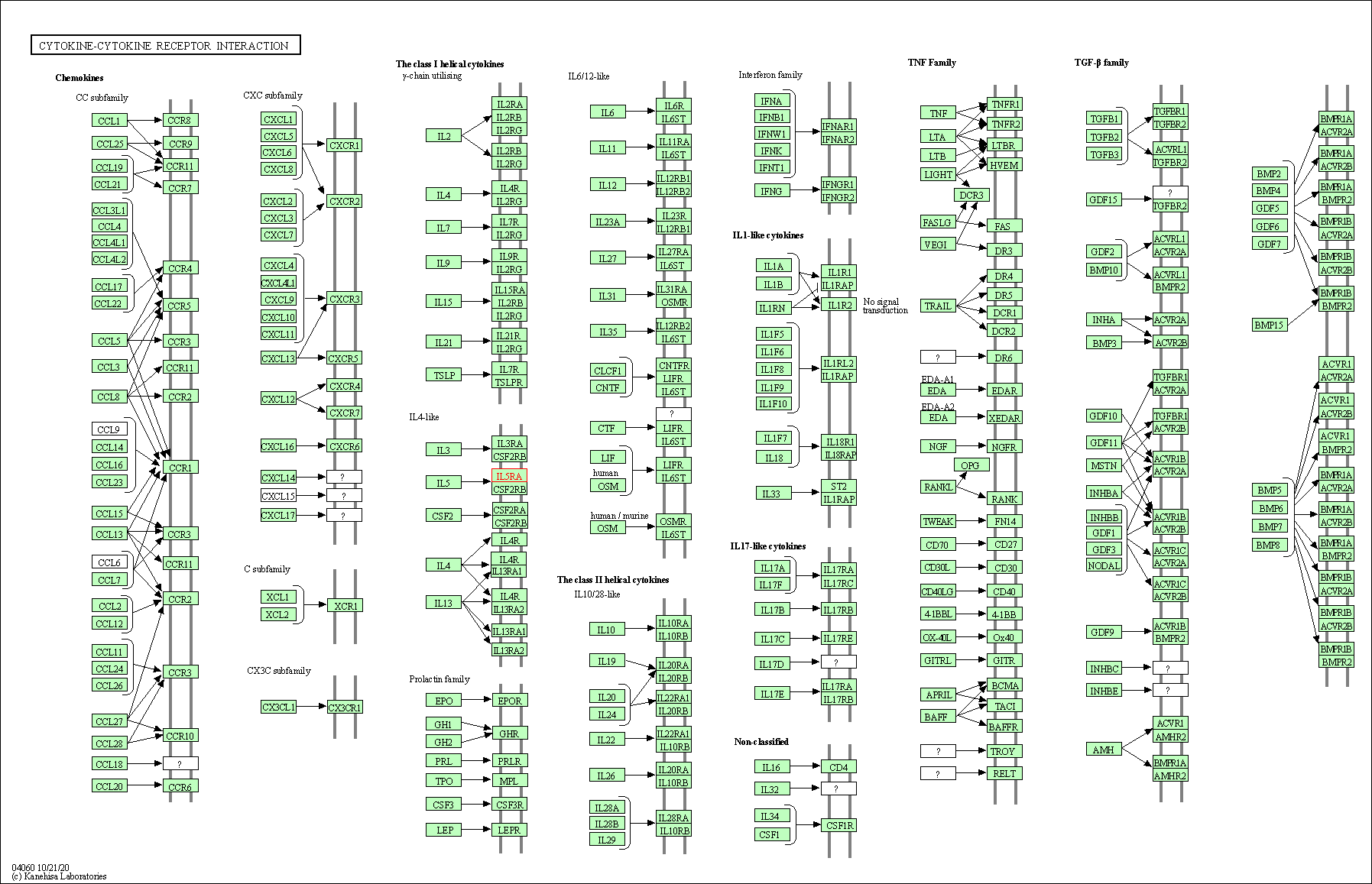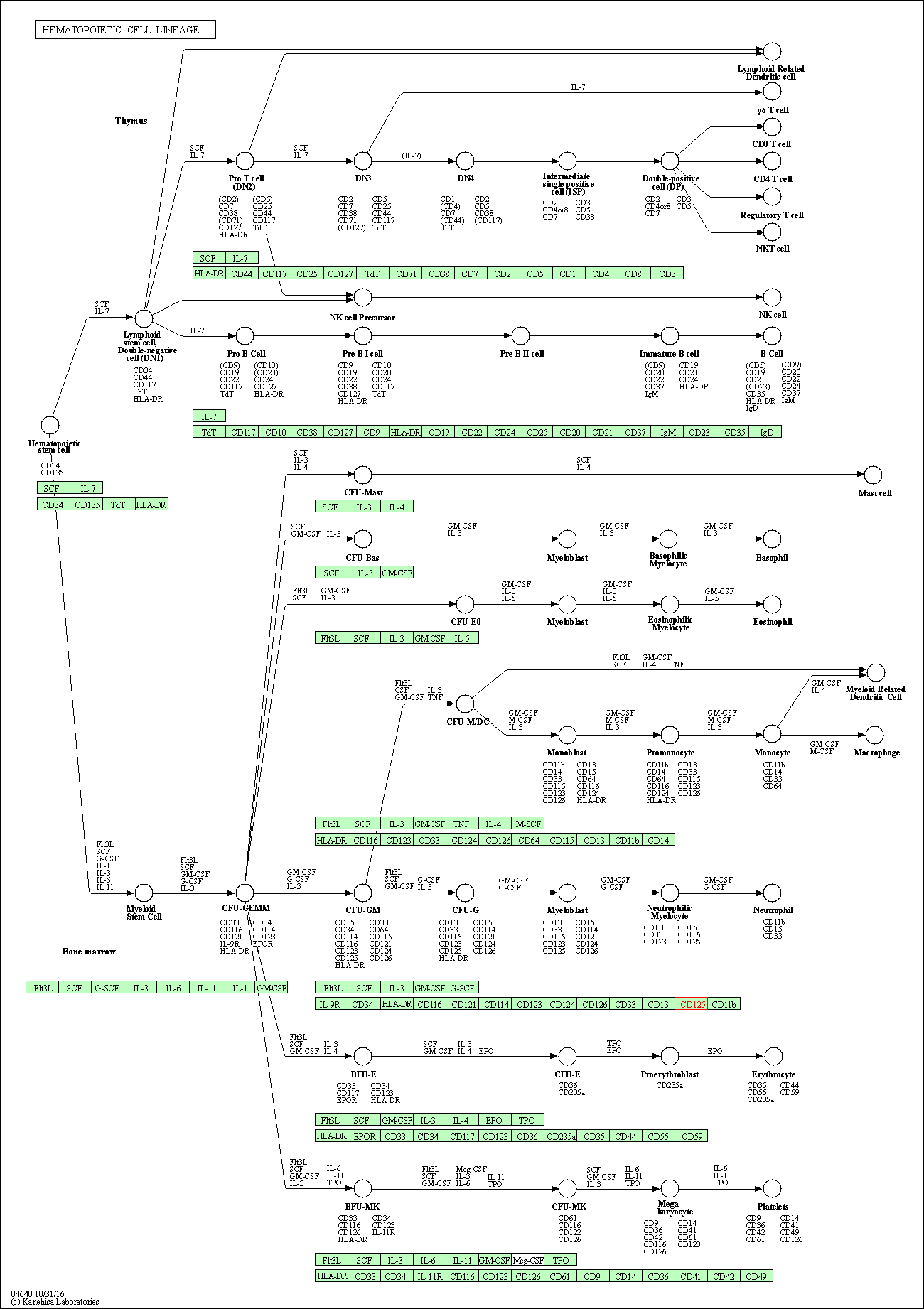Target Information
| Target General Information | Top | |||||
|---|---|---|---|---|---|---|
| Target ID |
T90828
|
|||||
| Target Name |
Interleukin 5 receptor alpha (IL5RA)
|
|||||
| Synonyms |
Interleukin-5 receptor subunit alpha; IL5R; IL-5RA; IL-5R-alpha; IL-5R subunit alpha; IL-5 receptor subunit alpha; CDw125; CD125
Click to Show/Hide
|
|||||
| Gene Name |
IL5RA
|
|||||
| Target Type |
Successful target
|
[1] | ||||
| Disease | [+] 1 Target-related Diseases | + | ||||
| 1 | Asthma [ICD-11: CA23] | |||||
| Function |
The alpha chain binds to IL5. This is the receptor for interleukin-5.
Click to Show/Hide
|
|||||
| BioChemical Class |
Cytokine receptor
|
|||||
| UniProt ID | ||||||
| Sequence |
MIIVAHVLLILLGATEILQADLLPDEKISLLPPVNFTIKVTGLAQVLLQWKPNPDQEQRN
VNLEYQVKINAPKEDDYETRITESKCVTILHKGFSASVRTILQNDHSLLASSWASAELHA PPGSPGTSIVNLTCTTNTTEDNYSRLRSYQVSLHCTWLVGTDAPEDTQYFLYYRYGSWTE ECQEYSKDTLGRNIACWFPRTFILSKGRDWLAVLVNGSSKHSAIRPFDQLFALHAIDQIN PPLNVTAEIEGTRLSIQWEKPVSAFPIHCFDYEVKIHNTRNGYLQIEKLMTNAFISIIDD LSKYDVQVRAAVSSMCREAGLWSEWSQPIYVGNDEHKPLREWFVIVIMATICFILLILSL ICKICHLWIKLFPPIPAPKSNIKDLFVTTNYEKAGSSETEIEVICYIEKPGVETLEDSVF Click to Show/Hide
|
|||||
| 3D Structure | Click to Show 3D Structure of This Target | AlphaFold | ||||
| Drugs and Modes of Action | Top | |||||
|---|---|---|---|---|---|---|
| Approved Drug(s) | [+] 1 Approved Drugs | + | ||||
| 1 | Benralizumab | Drug Info | Approved | Asthma | [2] | |
| Clinical Trial Drug(s) | [+] 1 Clinical Trial Drugs | + | ||||
| 1 | CSL311 | Drug Info | Phase 1 | Asthma | [3] | |
| Mode of Action | [+] 2 Modes of Action | + | ||||
| Modulator | [+] 1 Modulator drugs | + | ||||
| 1 | Benralizumab | Drug Info | [1] | |||
| Antagonist | [+] 1 Antagonist drugs | + | ||||
| 1 | YM90709 | Drug Info | [5] | |||
| Cell-based Target Expression Variations | Top | |||||
|---|---|---|---|---|---|---|
| Cell-based Target Expression Variations | ||||||
| Drug Binding Sites of Target | Top | |||||
|---|---|---|---|---|---|---|
| Ligand Name: Beta-D-Glucose | Ligand Info | |||||
| Structure Description | Structure of a cytokine ligand-receptor complex | PDB:3QT2 | ||||
| Method | X-ray diffraction | Resolution | 2.55 Å | Mutation | Yes | [6] |
| PDB Sequence |
KISLLPPVNF
16 TIKVTGLAQV26 LLQWKPNPDQ36 EQRNVNLEYQ46 VKINAPKEDD56 YETRITESKA 66 VTILHMGFSA76 SVRTILQNDH86 SLLASSWASA96 ELHAPPGSPG106 TSIVNLTCTT 116 NTTEDNYSRL126 RSYQVSLHCT136 WMVGTDAPED146 TQYFLYYRYG156 SWTEECQEYS 166 MDTLGRNIAC176 WFPRTFILSK186 GRDWLAVLVN196 GSSKHSAIRP206 FDQLFALHAI 216 DQINPPLNVT226 AEIEGTRMSI236 QWEKPVSAFP246 IHCFDYEVKI256 HNTRNGYLQI 266 EKLMTNAFIS276 IIDDLSKYDV286 QVRAAVSSMC296 REAGLWSEWS306 QPIYVGF |
|||||
|
|
||||||
| Click to View More Binding Site Information of This Target with Different Ligands | ||||||
| Different Human System Profiles of Target | Top |
|---|---|
|
Human Similarity Proteins
of target is determined by comparing the sequence similarity of all human proteins with the target based on BLAST. The similarity proteins for a target are defined as the proteins with E-value < 0.005 and outside the protein families of the target.
A target that has fewer human similarity proteins outside its family is commonly regarded to possess a greater capacity to avoid undesired interactions and thus increase the possibility of finding successful drugs
(Brief Bioinform, 21: 649-662, 2020).
Human Pathway Affiliation
of target is determined by the life-essential pathways provided on KEGG database. The target-affiliated pathways were defined based on the following two criteria (a) the pathways of the studied target should be life-essential for both healthy individuals and patients, and (b) the studied target should occupy an upstream position in the pathways and therefore had the ability to regulate biological function.
Targets involved in a fewer pathways have greater likelihood to be successfully developed, while those associated with more human pathways increase the chance of undesirable interferences with other human processes
(Pharmacol Rev, 58: 259-279, 2006).
Biological Network Descriptors
of target is determined based on a human protein-protein interactions (PPI) network consisting of 9,309 proteins and 52,713 PPIs, which were with a high confidence score of ≥ 0.95 collected from STRING database.
The network properties of targets based on protein-protein interactions (PPIs) have been widely adopted for the assessment of target’s druggability. Proteins with high node degree tend to have a high impact on network function through multiple interactions, while proteins with high betweenness centrality are regarded to be central for communication in interaction networks and regulate the flow of signaling information
(Front Pharmacol, 9, 1245, 2018;
Curr Opin Struct Biol. 44:134-142, 2017).
Human Similarity Proteins
Human Pathway Affiliation
Biological Network Descriptors
|
|
| Protein Name | Pfam ID | Percentage of Identity (%) | E value |
|---|---|---|---|
| Prolactin receptor (PRLR) | 23.237 (56/241) | 1.31E-06 | |
| Growth hormone receptor (GHR) | 21.402 (58/271) | 1.59E-04 |
| KEGG Pathway | Pathway ID | Affiliated Target | Pathway Map |
|---|---|---|---|
| Cytokine-cytokine receptor interaction | hsa04060 | Affiliated Target |

|
| Class: Environmental Information Processing => Signaling molecules and interaction | Pathway Hierarchy | ||
| JAK-STAT signaling pathway | hsa04630 | Affiliated Target |

|
| Class: Environmental Information Processing => Signal transduction | Pathway Hierarchy | ||
| Hematopoietic cell lineage | hsa04640 | Affiliated Target |

|
| Class: Organismal Systems => Immune system | Pathway Hierarchy | ||
| Degree | 4 | Degree centrality | 4.30E-04 | Betweenness centrality | 7.20E-06 |
|---|---|---|---|---|---|
| Closeness centrality | 2.02E-01 | Radiality | 1.35E+01 | Clustering coefficient | 3.33E-01 |
| Neighborhood connectivity | 1.98E+01 | Topological coefficient | 3.00E-01 | Eccentricity | 11 |
| Download | Click to Download the Full PPI Network of This Target | ||||
| Target Regulators | Top | |||||
|---|---|---|---|---|---|---|
| Target-regulating Transcription Factors | ||||||
| Target-interacting Proteins | ||||||
| References | Top | |||||
|---|---|---|---|---|---|---|
| REF 1 | Benralizumab--a humanized mAb to IL-5R with enhanced antibody-dependent cell-mediated cytotoxicity--a novel approach for the treatment of asthma. Expert Opin Biol Ther. 2012 Jan;12(1):113-8. | |||||
| REF 2 | 2017 FDA drug approvals.Nat Rev Drug Discov. 2018 Feb;17(2):81-85. | |||||
| REF 3 | ClinicalTrials.gov (NCT04082754) A Clinical Study to Test the Safety, Exposure, and Pharmacodynamic Markers of CSL311 in Subjects With Mild-to-moderate Asthma and in Healthy Volunteers. U.S.National Institutes of Health. | |||||
| REF 4 | Anti-beta(c) mAb CSL311 inhibits human nasal polyp pathophysiology in a humanized mouse xenograft model. Allergy. 2020 Feb;75(2):475-478. | |||||
| REF 5 | Characterization of YM-90709 as a novel antagonist which inhibits the binding of interleukin-5 to interleukin-5 receptor. Int Immunopharmacol. 2002 Nov;2(12):1693-702. | |||||
| REF 6 | Structure analysis of the IL-5 ligand-receptor complex reveals a wrench-like architecture for IL-5RAlpha. Structure. 2011 Dec 7;19(12):1864-75. | |||||
If You Find Any Error in Data or Bug in Web Service, Please Kindly Report It to Dr. Zhou and Dr. Zhang.

